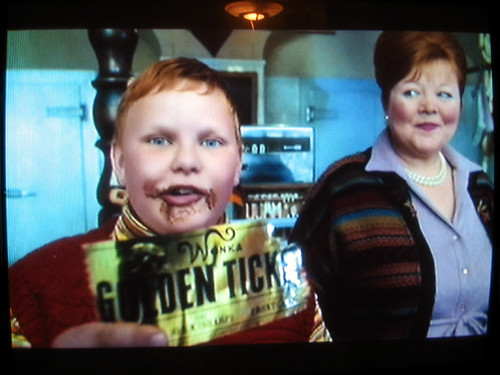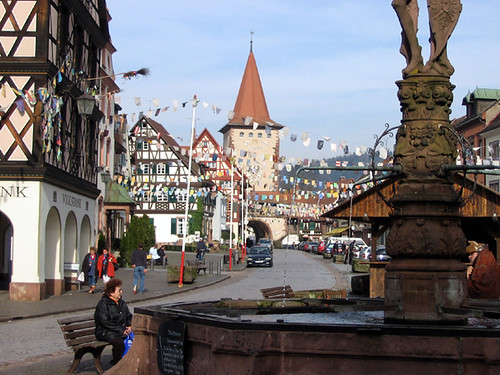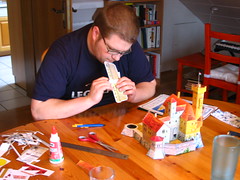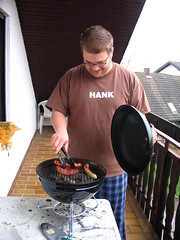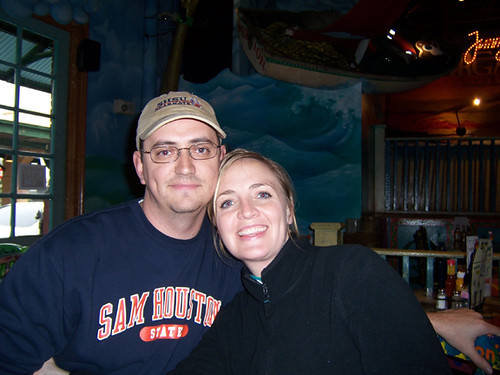Grüße aus...München! (Part I)
Karl needed to go to Munich on Monday, February 11th, for work so I decided to go with him since I have never seen Munich. He decided to take Tuesday off work so that we could spend an extra day in Munich together.
We took the train in on Sunday afternoon and Karl showed me around the city center. He had taken a couple of trips to Munich while he was on his study abroad in Esslingen. We went into a few beautiful churches and had a late lunch at a very Bavarian and (a little touristy) restaurant in the city center. The city center was very beautiful...if very restored. Unfortunately a huge part of Munich was destroyed (like many German cities) in World War II. And many buildings were, thankfully, if obviously, restored.
The next day, Monday, as Karl was busy with his work thing, I went into the city center and took a Munich City Walk tour. The tour I chose was their Third Reich tour. For 2 1/2 hours we were shown Munich through Hitler's eyes...it was fascinating!
Adolf Hitler was first introduced to the German Worker's Party as a spy. He attended a meeting of this minor political party when he assigned to investigate it as a police spy. The meeting took place in this building (which is now a bed store):
Hitler was personally impressed with the party's ideas. Before long was was not only a party member but became head of their propaganda. And before much longer, Hitler changed the title of the part to the National Socialist German Worker's Party in 1921 and announced the formation of this new party as its leader in this room:
This is the upper hall of Munich's most famous beer hall: the Hofbräuhaus. In this room, standing, not on the stage or at a podium, but on the floor in the center of the room, he announced this new party and its goals and ideals. (Unfortunately, we were not allowed to enter the room, so the only photo I was able to take was through its glass doors with its strange reflections.)
As we continued our walk through Munich, we passed its beautiful opera house:
Hitler loved the opera. Particularly the operas of Wagner, whose operas were about the great German legends. Our tour guide told us an interesting anecdote illustrating both his love for opera and his lack of friendship skills. One long night during a Wagner opera, some party friends of Hitler fell asleep during the performance. He was so offended by this that he had these men attend the opera again the next night and made them stand up during the entire 4 hour performance. No wonder Hitler's favorite architect would say "If Hitler had a friend, I was the closest thing to it."
We passed by the Feldherrnhalle...
...and stopped on the left side of it which had once been a Nazi cult sight. In 1923 Hitler decided it was time to overthrow the Bavarian government preparatory for his overthrow of Germany's capital, Berlin. However, this Beer Hall Putsch didn't go very smoothly. As the party marched from the beer hall to the Bavarian War Ministry, the police barricaded the street next to the Feldherrnhalle at exactly this point...
...and several party members were killed. After Hitler's rise to power this point, where men had given their lives for the party, became a memorial. And everyone who walked past it had to salute the memorial. Those people who preferred to practice a passive-aggressive protest, walked instead through an alley behind the Feldherrnhalle to avoid having to make the salute. This alley...
...thus became nicknamed Dodger's Alley and is today marked with gold-colored stones.
Next we walked to the Bavarian government building--also heavily destroyed, hence the newer glass additions. (The front facade, however, is still original, including the scars of WWII ammunition in the columns.) The rectangular stone form standing directly in front of the building is a memorial to fallen Bavarian soldiers in both the World Wars.
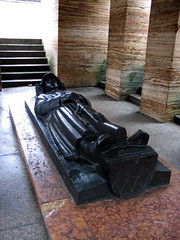
Also in front of the building is this simple memorial to German Dissenters. Quotes from dissenters are etched in the granite. At this point our tour guide, Sebastian, talked about the Germans who resisted the Nazi party. This granite memorial had a quote from the White Rose group who wrote leaflets calling for active opposition to the party. But Sebastian went into detail on one of his personal heroes, Georg Elser.
Just behind and around the corner from the Bavarian government building was an illustration of Nazi architecture: the Haus der Kunst.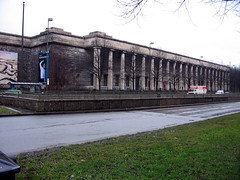
This Nazi-built art museum housed a great exhibition of Nazi art in 1937, called the Great German Art Exhibition, during which, behind us in a nearby building, the exhibition of Degenerate Art took place. This was an exhibition of modern, German Expressionist art that was banned by the Nazi Regime. Their intention for this exhibition was to ridicule the art...however the Degenerate Art exhibition had three and a half times more visitors than the Great German Art Exhibition. Because the art was slated to be burned after the exhibition, people came because they knew it would be their last chance to see this great and important art being made in Germany. The artists included in the exhibition were declared enemies of the state. Luckily, most of the art was sold to museums in other nations when the Nazis realized how much money they could get for it.
Our final stop was at the center of the Nazi Party administration which is off of Königsplatz, the location of Hitler's great book burning in 1933.
This group of over 50 buildings once covered this area of Munich. Many of the buildings were destroyed after the war, including the building known as the Brown House in which Hitler's deputy and staff worked:
The foundations of the building have been uncovered, and a new information center on the Nazi Regime is currently being built on the location.
Two Temples of Honor were also destroyed, with only their bases remaining:
Remember the party members that died near the Fernherrnhalle during the Beer hall Putsch? Eventually, Hitler had their bodies entombed in these temples that were kept under guard and became Nazi cult sites.
But not all the party buildings were destroyed. Just beyond the base of the Temple of Honor above, you can see the former Nazi Party Administration building. After the war, this building housed the committee recovering Nazi looted art. It now holds an art history and graphic institute.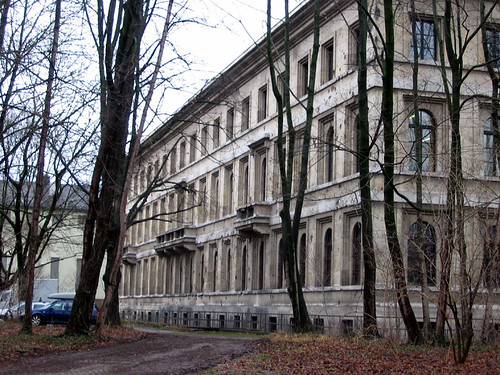
Note all the damage on the building from the war.
The building above is now a music school but was once the Führer building. And this is where we ended our tour: on the steps looking over at the room that was once Hitler's Munich office, where musicians were now holding a rehearsal.
I found this tour very fascinating. One of the most interesting aspects of it is that our young tour guide, Sebastian, was himself a German. He even mentioned that his grandfather had been in Hitler's bunker at the end of the war and even saw Hitler's body after he had committed suicide. I have rarely heard this dark period in Germany's history spoken about by Germans. And usually the stories I have heard about the war from Germans were about some of the horrible things they had to go through immediately after the end of the war. But I can't believe it is a period of history that Germans don't at least think about. It seems that the the anti-Nazi propaganda the Allies began immediately after the war is still in place: Holocaust memorials can be frequently found and World War II documentaries are almost constantly on TV here. But I think it is slowly becoming a subject that the upcoming generations are more willing to discuss...for instance, more and more German-made holocaust films are being made. One of which inspired me to seek out a certain location in Munich after my tour...
The White Rose was an organization of five students and a professor at the University of Munich. They secretly published and distributed leaflets calling for active opposition to the Nazi regime. On February 18, 1943, the students brought a briefcase of leaflets to the university. Hans and Sophie Scholl (they were brother and sister) left stacks of leaflets in the empty hallways for students to find when classes let out. On a whim, Sophie took one last stack and flung it into the air over the atrium. A custodian witnessed this last act and notified the police. The siblings were arrested along with fellow member, Gustaph Propst, and were quickly tried and executed. The other members of the White Rose were also eventually executed. A wonderful film called Sophie Scholl: The Final Days depicts this event.
So off I went to the university building where the Sophie Scholl had thrown her leaflets:

Just off of the atrium is a little museum about the White Rose. On the wall of the atrium is a memorial to the White Rose. And in front of the building, on the ground, and made to appear as leaflets, is a monument to the White Rose.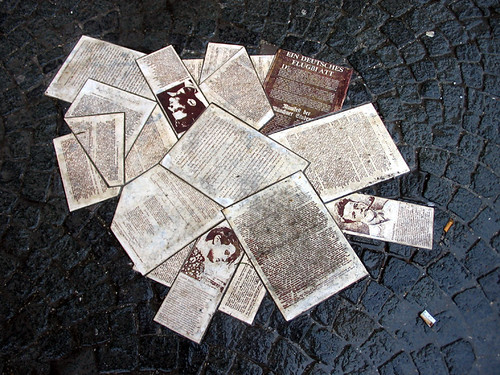
I really had a fascinating day exploring Munich's darker side. But the next day, Karl and I discovered a completely different side of Munich! But I'll get to that a little later....
